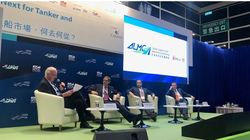Weak fundamentals cloud tanker market

Martin Stopford was downbeat about oil tanker markets on market fundamentals, but his fellow panellists from the shipowner and operating side argued there is still plenty of upside in VLCC and suezmax markets.
Supply is expected to exceed demand in the oil tanker sector next year, according to Clarkson Research president Martin Stopford
SHIPPING EXPERTS AT A SHIPPING FORUM AT THE ASIAN LOGISTICS AND MARITIME CONFERENCE IN HONG KONG.
THERE were divided views on the outlook for the tanker market expressed during a shipping forum at the Asian Logistics and Maritime Conference being held in Hong Kong.
Clarkson Research president Martin Stopford was downbeat about oil tanker markets in general against a backdrop of weak fundamentals.
The shipping economics expert predicts a surplus in ship capacity next year, with a total fleet growth to reach 3.2% versus a 2% increase in tonne-mile demand.
That was a result of a hefty delivery — 30.4m dwt — in 2019 in the sector, coupled with a perceived slowdown in ship scrapping as well as world oil demand.
“Really, there’s not a lot of underlying strength in the market,” Mr Stopford told the audience.
He did concede that the current speculative pump prices and active contango trades might create a shortage in vessel supply and lead to good rates for a few months.
“But it’s hard to get the sort of really high level of asset appreciation that you’d like to see,” he added.
William Fairclough, chief commercial officer at Wah Kwong Maritime Transport, suggested the bird’s-eye view might have overlooked some upside potential in certain segments, especially the very large crude carrier market.
“VLCC is very often driven by political issues, not supply and demand pictures,” he said.
Two key events that Wah Kwong is focusing at the moment are the US sanctions on Iran and the capacity-slimming plan of the Organisation of Petroleum Exporting Countries.
Washington’s latest bans against Iran’s oil exports were viewed as a positive factor because the move had helped remove Teheran’s large state-owned tanker fleet from the global markets, hence reducing overall tonnage supply.
Saudi Arabia’s recent signal to cut oil production, on the other hand, affected the outlook in a negative way, although the issue remained very dynamic, according to Mr Fairclough.
And the tanker sector had some reasons for optimism, he further argued.
The 2020 sulphur regulations were driving the demolition of old tonnage, in particular the first-generation, double-hull tankers built about 2000, while the increasing crude exports from the US to Asia were creating more tonne-mile demand.
“I endorse William’s optimism at least for the next couple of years,” said Penfield Marine managing director Giovanni Gavarone, adding that large vessels, such as VLCC and suezmax will benefit the most from the increase in trade distance.
In the long term, however, Mr Stopford thought the seemingly unstoppable growth in global oil demand would likely come to an end in the next 10 years because most of the world is moving towards a low-carbon society.
“The tankers industry needs to start think about changes that are going to happen in the long term and how they are going to deal with them in terms of their investment and relationship with energy customers.”